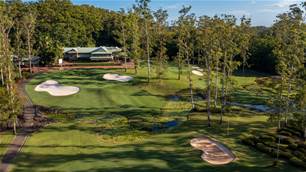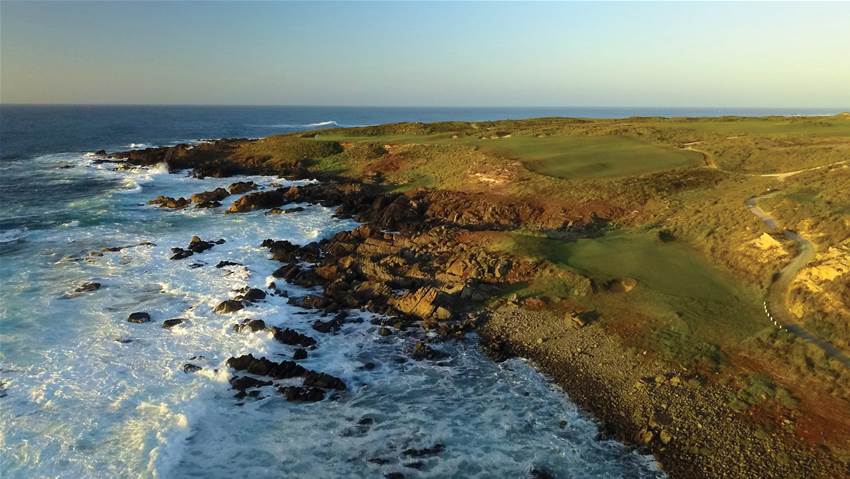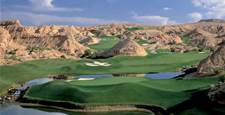Cape Wickham boasts postcard views at almost every turn, which can distract from appreciating just how good this links layout really is.
Walking onto the 1st tee at Cape Wickham Links never, ever, disappoints.
I have been lucky enough to play some of the world’s greatest courses including Augusta National, Royal Melbourne and the Old Course at St Andrews. Stepping up to play your opening tee shot at each of these magnificent golfing colosseums stirs an excitement you know you have to get a handle on just to draw the club back away from the ball. It’s as much about the history and the anticipation of playing the holes that lie ahead that add a few beats to the heart rate.
The first time I played Cape Wickham, shortly after it opened in October 2016, there were no excited butterflies fluttering in the stomach as I teed a ball ready to play. Perhaps it was the calming effect the ocean outlook, across Victoria Cove to the right of the generously wide 1st fairway, had on me.
But I have since come to realise, having played the course a few times since, it was the mystery of what lay ahead that had me nerveless on that first day. Now that I’m more familiar with what is coming, pegging a ball on the 1st at Cape Wickham gets the nerves jangling beautifully
Here’s why.
Cape Wickham is remote, exposed, windswept, stunningly beautiful and, ultimately, unforgettable.

Originally used for cattle grazing, the site was discovered by founder and former chief of golf course construction company Programmed Turnpoint, Andrew Purchase, during a trip to the island in 2011.
He, like everyone who has visited since, was struck by the beauty of the location, about 40 minutes’ drive from the island’s biggest town, Currie, to the north-west coast and in view of the heritage-listed lighthouse of the same name.
Melbourne-based golf writer Darius Oliver along with Duncan Andrews, the owner and developer of The Dunes and Thirteenth Beach, brought American course designer Mike DeVries into the mix as each began to see the site’s phenomenal potential. Andrews financed the project under the proviso the necessary Tasmanian authorities grant a long-term lease for the most desirable land adjoining the small parcel of land he had purchased. Construction work, based on a design by DeVries in collaboration with Oliver, began in June 2013 and the course officially opened on October 30, 2016.
“Now that I’m more familiar with what is coming, pegging a ball on the 1st at Cape Wickham gets the nerves jangling beautifully.”
Within months it was ranked the No.1 Public Access Course in the country by Golf Australia magazine, tipping out fellow Tassie course Barnbougle Dunes from the premier spot for the first time in more than 15 years. Cape Wickham retained its spot on top of the Top-100 list when the 2019 ranking was published two months ago. Adding to this acclaim, overseas golfing publications have the King Island layout ranked as high as No.24 in the world.
I am often asked by those, who have yet to dine on the golfing buffet Cape Wickham offers, “It looks great in photos but is it really that good?” The simple answer is “Yes, yes it is.”
DeVries and Oliver – bearing in mind the impact of Mother Nature – could have produced one of the hardest golf courses on the planet. But they didn’t, preferring to create 18 holes of fun golf with no two rounds ever being the same.

Cape Wickham has been crafted to take the wind, which can blow up to 35km an hour on a regular basis, and wind direction into account. As a result, the layout offers generous playing corridors and holes that provide fair strategies regardless of the wind strength and direction. A scheme of fairway bunkers that is scarcely in play one day will move squarely into the zone the next. The focus of the design team on playability no matter what Mother Nature conjures up by providing a variety of playing lines and numerous shot options is an enticement to play this layout time and time again to experience all it has to offer.
While Mother Nature might have one hand on the fan, she doesn’t – contrary to popular belief – have the other hand on a hose in these parts. Locals refer to the north of the island as “the desert”. Such is the disparity in rainfall, the area surrounding Cape Wickham often receives half the precipitation of other parts of the island, which is ideal for the firm, manicured fescue fairways and greens you will find at Cape Wickham.
As mentioned, the opening tee shot provides plenty of excitement as you play to an expansive rolling fairway that is flanked by scrub covered dunes to the left and stops at the edge of a cliff to the right. The 340-metre par-4 is the first of eight holes set hard against the ocean, and while it isn’t the hardest of the bunch it does challenge you to hit the correct side of the fairway to leave the best line into the pin position of the day.

While DeVries and Oliver could easily have hung their hat on the stunning ocean side holes, thankfully they didn’t – and the inland holes at Cape Wickham are as thrilling to play as those by the water. The 447-metre par-5 6th is a fine example. Here, the fairway rises gradually before veering right around a pod of deep bunkers cut into the side of a grassy dune to the right. The massive green is reachable in two shots in the right conditions and the ‘Wickham experienced’ player will aim left of the greenside bunkers and let the dramatic slopes feed their ball around to a right half flag.
The seaside par-3s at the 3rd, 11th and 17th will always catch the attention of photographers, although one of the best to play is the 7th. The hole climbs slightly during its 137 metres to a green angled from front left to back right with a giant swale capturing any shot coming up short or right. A hump short and left and a dune hugging the left edge provide the key contours and will allow canny shots to feed close to certain pin positions. It’s a genius short hole where the correct strategy might reveal itself only after you have played it a few times.
“The inland holes at Cape Wickham are as thrilling to play as those by the water.”
During my visit to compile this review I played the layout late in the afternoon and was making a really good fist of breaking 80 for the first time at Cape Wickham. I played the long par-5 15th heading out towards the lighthouse downwind and got a little adventurous with my third shot, a pitch from 40 metres, which stopped on the edge of a steep slope above the green to the right and took me three more shots to find the bottom of the cup.
The 16th tee is the start of the final run to the clubhouse, with the coastline ever-present to the right of all three holes.
The 16th quite rightly is rated the hardest on the course. It is a 377-metre par-4 with a terraced fairway that kicks everything towards the rocks and shoreline on the right and a hard-to-access green with trouble all around. The long par-3 17th is no picnic either with a hump in the centre of the green ready to repel shots lacking the required shape.

The 18th is the ultimate crescendo. A crescent-shaped dogleg-right, it curls around Victoria Cove from all the tees. The beach and lapping waves are very much in play and the high dune flanking the left often shields balls from the wind, which can add to the intricacy of the finish. A lone bunker short and left of the green asks golfers to hug the dangerous right edge of the fairway from the tee in order to set up the ideal angle in, but taking that line requires considerable bravery. I was a little too brave and added a double bogey six to the triple bogey six on 17 and another double on 16.
It was a horrible finish that was quickly forgotten as I ploughed into a King Island Eye Fillet with vegies in the temporary clubhouse restaurant. The sun was setting and the mutton birds were returning from a day at sea, while a lone fisherman went about his business off shore. Later, I stood on the back deck of my room above the 1st fairway and stared out into the pitch black, which was punctuated by a show of a million stars and the piercing beam every few seconds from the lighthouse. What a place!

THE COURSE
LOCATION: Cape Wickham, King Island, Tasmania.
CONTACT: (03) 6463 1200.
WEBSITE: www.capewickham.com.au
DESIGNERS: Mike DeVries with Darius Oliver.
SLOPE RATINGS: 137 (blue tees), 134 (white), 127 (red).
PLAYING SURFACES: All fescue.
COURSE SUPERINTENDENT: John Geary.
GREEN FEES: $175 (18 holes); $220 (all day rate). *Note, the course is closed from July 1 to August 31.
HOW TO GET THERE: Three Melbourne airports have flights to King Island, with Regional Express (REX) flying out of Tullamarine, Sharp Airlines flying out of Essendon, Air Adventure flies charter flights and is also based out of Essendon but has some select flights out of Moorabbin and Vortex Airlines flies charter flights out of Moorabbin. The flight time from Melbourne to King Island is between 35 and 45 minutes depending on the type of aircraft and weather conditions.
ACCOMMODATION: There are 16 ocean view units perched on the side of the opening hole, overlooking Victoria Cove and on to Cape Wickham Lighthouse. Each room includes two king single beds or one double bed with en suite. There is a safe, fridge, TV, reverse cycle air-conditioning and Wi-Fi. Complimentary continental breakfast is available in the clubhouse.
RESTAURANT: The temporary clubhouse provides breakfast, lunch and dinner (dinner to in-house guests only).
Related Articles

Course Review: Cape Kidnappers

Review: Bonville Golf Resort












